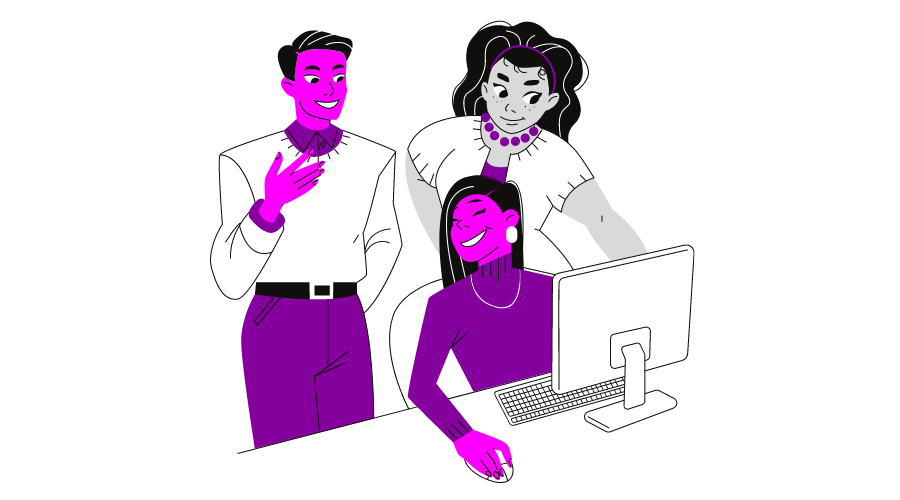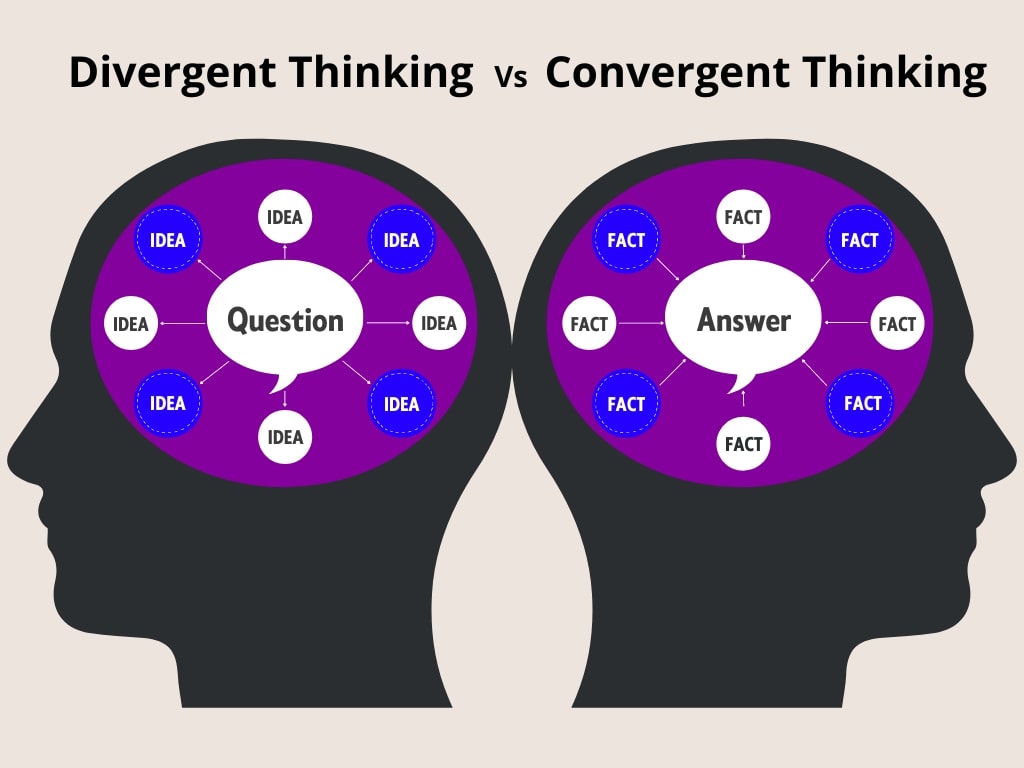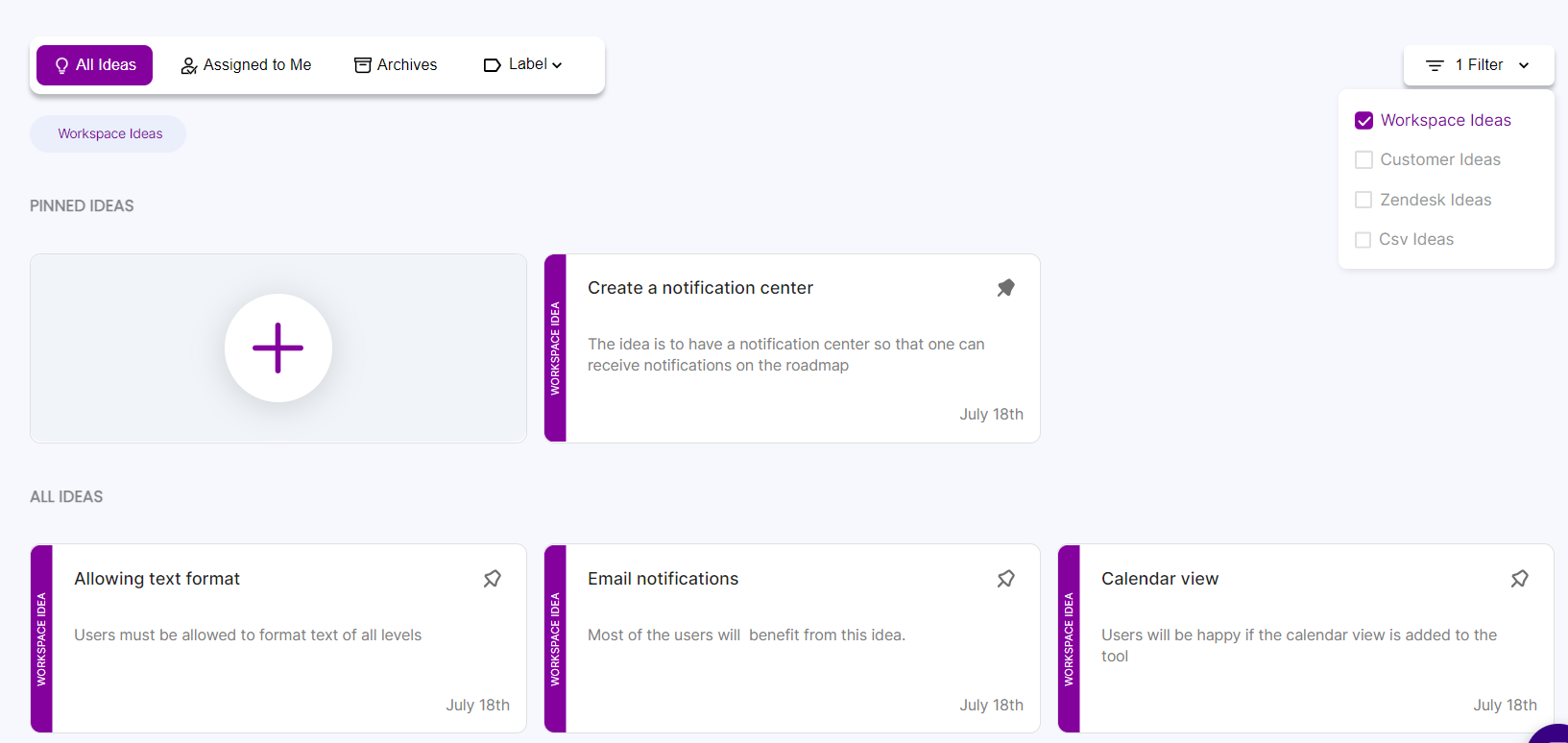What Is Divergent Thinking? [Definition and Examples]
March 21, 2022 Max 7min read

What Is Divergent Thinking?
Divergent Thinking Definition
“Divergent thinking is also called lateral thinking. It is a thought process of coming up with varied creative ideas to overcome a problem and generate a solution.”
Divergent thinking is often a non-restricted, non-linear, and free-flowing chain of thoughts to let new ideas come as and when they occur.
Six thinking hats are techniques used to come up with such unique ideas.
The term divergent thinking was coined by the psychologist J.P Guilford.
A divergent thinker does not necessarily have a high IQ. Yet, they are curious and often easily take risks.

What Is the Difference Between Convergent and Divergent Thinking?

Convergent thinking is the simple process of finding a single solution to any problem. On the other hand, divergent thinking searches for various solutions to a problem.
A convergent thinker will take a straight path to reach a solution. A divergent thinker takes multiple paths of twists and turns to solve a problem.
A convergent thought is accurate, fast, and logical. A divergent thought has expansive, impulsive, and irregular characteristics.
The convergent thinking method inspires the already tried and tested techniques and reuses them. Divergent thinking does not focus on the existing, proven techniques.
As the name suggests, divergent means varying. Hence, a divergent thinker will choose from the innumerable solutions available, even though they might not relate.
A convergent thinker believes that the world is black and white and would not explore other options.
On the other hand, a divergent thinker takes a black and white approach. However, they are ready and open to exploring other available possibilities.
Whatever the difference may be, both convergent and divergent thinking complement each other.
For such variety of ideas, we recommend you to try out Chisel’s newly launched ideabox feature. It enables you to capture and store all your unique ideas for future implementation.

Register to use this premium feature today!
What Are Some Divergent Thinking Examples?
A convergent thinker may declare a person as sick or healthy.
On the other hand, a divergent thinker may say that a person can be both sick and healthy.
For example, You might be stressed but could be physically fit.
Another example of divergent thinking is that a divergent thinker mostly thinks like writing an essay.
A divergent thinker will write an essay in no right or wrong way. It will be free-flowing ideas, and you will creatively find the answer.
To give you a better understanding, let us look at the real-world examples of how companies have successfully used divergent thinking.
Spotify
Spotify, founded by Daniel Ek, initially aimed to create a free music streaming service with instant playback but faced financial challenges. To make the business viable, they deviated from their original concept by introducing a premium subscription model. This decision not only made Spotify hugely successful but also pioneered the “freemium” model, where users have both free and premium options, and the concept of “product-led growth.”
It highlights the importance of adapting and evolving to overcome challenges and how innovative thinking can transform an industry, in this case, music streaming.
Apollo 13
In April 1970, during the Apollo 13 mission, a critical oxygen leak and explosion damaged the spaceship’s life support systems, putting the lives of the three astronauts on board at risk. They couldn’t filter out carbon dioxide anymore, creating a dire situation. The crew and mission control had to come up with a creative solution to save the mission.
In an incredible display of ingenuity, they improvised an air-filtering device using everyday items like binder covers, plastic bags, and other available materials. This makeshift solution successfully resolved the crisis, allowing all the astronauts to return safely to Earth. This heroic and resourceful rescue of the Apollo 13 crew is one of the most famous moments in space exploration history. It even inspired a motion picture, with Tom Hanks receiving an Oscar nomination for his portrayal of the events 25 years later.
Key Highlights:
- Divergent thinking is a creative process of generating multiple solutions or ideas to address a challenge. It is the opposite of convergent thinking, which focuses on finding the best solution.
- Divergent thinking is essential for innovation. It allows us to think outside the box and develop new and unexpected solutions to problems.
- Examples of divergent thinking include brainstorming a list of ideas for a new marketing campaign, coming up with different ways to improve a customer service process, and designing a new product or service that meets the needs of a specific customer group.
What Are Some Divergent Thinking Benefits?
Best Solution
Divergent thinking helps develop unique solutions to the issue at hand.
A divergent thinker is likely to explore all the possible solutions to the issue and choose the one that suits perfectly.
Boosts Teamwork
Brainstorming ideas is a part of divergent thinking, when the first and the most basic idea is dismissed, it makes room to invite ideas out of the box.
The divergent thinking team ensures that everyone’s ideas are heard and not dismissed without giving an unmistakable thought of comparison.
Thus, it enhances collaboration and team morale.
We need excellent software to ensure that teamwork continues to work without hindrance no matter where a team member lives to boost team collaboration. The best product management software like Chisel, promotes seamless team collaboration.
Higher Flexibility
In times of complex problems, a divergent thinker facilitates proactive problem solving instead of restrictive problem-solving.
It allows the team to adjust their plans and processes to accommodate the new solution.
Encourages Innovation
J.P. Guildford, a psychologist, noted 1956 that divergent thinking is an essential spark for creativity. It involves coming up with new and original ideas, as well as boosting creative thinking by encouraging “outside-the-box” solutions. Furthermore, the attribute of elaboration, essential to divergent thinking, allows for the development and practical application of unique concepts, fostering creative thought and problem-solving even further.
Ace at Problem Solving
Problem-solving is a fundamental skill, and divergent thinking is key to finding the most suitable solutions to excel in your role.
Divergent thinking techniques, such as unrestricted idea generation, empathetic perspective shifts, mind mapping for idea associations, and problem reframing as questions, are crucial in enhancing creative problem-solving abilities.
How to Use Divergent Thinking?
You must ensure that your team practices divergent thinking in moderation, as too much of anything are harmful.
Excess divergent thinking can bring in a pool of ideas without a solution or implementation.
That is where convergent thinking becomes useful. Convergent thinking organizes and structures the thought process, separating those with quality and potential from the others.
Divergent thinking is needed to gather free-flowing and non-linear ideas.
However, to give these ideas some structure, convergent thinking is essential. Both of these are valuable.
While on the one hand, divergent thinking empowers an individual to explore all the possibilities and options. On the other hand, convergent thinking ensures that you choose the right solution.
Let us look at how you can combine these two aspects effectively.
The first step is to start with divergent thinking. Your team must be agile. Say goodbye to the normal ideation process you have been doing and come up with something new. Always note that none of the ideas can be wrong. Open-mindedness is the key.
As Adam Grant notes, “When you put off a task, you buy yourself time to engage in divergent thinking rather than foreclosing on one particular idea.” This perspective aligns with the notion that divergent thinking thrives when all possibilities are explored without premature judgment.
Therefore, next in line is exploring all the ideas from various perspectives, but mainly from the lens of your target audience. How well does your idea cater to your audience? What problems is the idea aiming to resolve?
Finally, convergent thinking comes into the picture that involves objectively assessing existing options. Here, you need to conduct a thorough analysis of the available choices, considering their pros and cons. By compiling a comprehensive list of the strengths and weaknesses of various ideas, you can more effectively identify and select the best ones to pursue further.
How to Improve Your Divergent Thinking Skills
Improving your divergent thinking skills involves honing your ability to generate various creative ideas and solutions. Here are some effective strategies to help you enhance your divergent thinking skills:

- Practice: Like any ability, divergent cognition can get enhanced through repeated exercise. Schedule dedicated sessions routinely, along with engaging in creative problem-solving techniques. It may involve setting aside time for conceptualizing and idea-generation activities.
- Brainstorming: Collaborative brainstorming is an established method for fostering divergent thought. Convene a working group encouraging open conceptualization without intersession critique to facilitate an unconstrained flow of solutions.
- Mind Mapping: Employing visual mind maps allows representing ideas and their interconnections graphically. Begin with a core problem/concept and branch associated thoughts, links, and potential remedies. This nonlinear visualization approach explores alternative pathways.
- Free Association: Practice free association by permitting cognition to progress freely without constraints. Commence with a stimulus, then trace naturally emerging related conceptual chains. This technique may uncover unexpected creative connections.
- Lateral Thinking: Approaching issues from non-standard angles using hypothetical scenarios, conversion, or perspective modeling encourages novel perspectives and remedies.
Incorporating such practices into your routine can cultivate more proficient divergent cognition over time. Creativity and innovative conceptualization may get enhanced through consistent endeavor and exploratory evaluation. Committing to these methods offers opportunities to strengthen divergent thinking capacities.
FAQs
Divergent thinking is a thought process of gathering spontaneous, non-linear ideas that help explore all the possibilities to tackle an issue.
Convergent thinking is a process of organizing ideas and thoughts. It provides clarity in making a good decision.
Creativity is the ability to gather a unique set of solutions and ideas.
And as we already know, divergent thinking requires immense curiosity, creativity, and openness to exploring ideas to achieve solutions.
In this way, divergent thinkers must be curious as well as creative to be able to generate innovative solutions.
Divergent thinking takes place in an open and spontaneous environment. It allows the mind to flow freely in many directions.
And this space lets the mind focus on varied ideas rather than the available techniques.
Hence, solutions are born cognitively.
